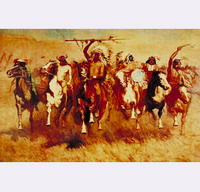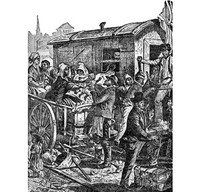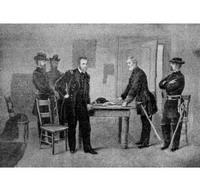At the beginning of XIX century. U.S. chain was the state that stretched for 2 thousand kilometers along the Atlantic coast. To the west of these lay vast land inhabited nechyselnymy Indian tribes. In the southwest rozpochynalysya Spanish possession.
U.S. President from 1800 was Thomas Jefferson, author of the Declaration of Independence. He represented the Republicans, who advocated an active capturing of new lands.
first great heritage of territorial administration Jefferson of Louisiana was bought around 15 million in France in 1803
As a result, the U.S. has doubled. Further territorial acquisition by the end of XIX century. formed throughout the country. That, in general, and it remains to this day.
Simultaneously with the increase of territory rapidly growing population. In 1800 it was 5.3 million, in 1820 - 9,6, in 1840 - 17 and in 1860 - 31.5 million people. In fact, every ten years the population of the United States increased by one third. This was, above all, by constantly increasing immigration.
At the same time dramatically decreased the continent's indigenous population - Indians. The level of development they are significantly inferior to Europeans and could not defend their land. At the time of the discovery of America by Columbus H. inhabited the territory of modern USA 10.12 million Indians, and at the end of XIX century. they have only 200 thousand
Due to lack of workers on the continent to the Americas from the XVII century., imported blacks slaves. During the first half of XIX century. their numbers steadily increased: from 1.19 million persons in 1810 to 4 million in 1860
Attitudes toward slavery in different regions of the USA was not the same. In the north and west of the country condemned slavery and it was canceled. In the south, in the case concerning the use of slave labor the moral side of the inferior economic benefit. That is why slavery persisted.
first half of XIX century. the North was a period of rapid deployment of the Industrial Revolution. South slavery at the same time save the agrarian nature of the economy and more and more behind in its development. Nevertheless, the leadership the country was in the hands of representatives of southern states. The situation is compounded and that Southern slaveowners tried to extend the system of managing plantations to new lands of the West, where between opponents and supporters of slavery there were sometimes fighting.
North's political leaders advocated the elimination of slavery throughout the country. Southern Planter saw in those plans threat to their way of life. Many of them argued for separation from the U.S. and create their own state. After winning the presidential election of 1860 Republican Abraham Lincoln, who was strongly opposed to slavery, Southern planters moved to act decisively.
first withdrawal from the U.S. in December 1860 declared South Carolina, and in February of 1861, 11 southern states announced the creation of a new state-of the Confederation of American States. April 12, 1861 its forces captured Fort Sumter, where he was allied garrison. U.S. Civil War began.
During the Civil War on the side of the Union (North) were 23 states with a population of 22 million people and Confederation (South) supported the 11 states (in May 1861 they were joined by another 4 states) with population of 9 million, of which 4 million slaves were Negroes. In economic terms North gave 92% of all industrial countries, and South - 8%.
At the outbreak of war neither party had a specific plan of war, trying to win by a decisive battle and capture the capital.
However, these attempts were unsuccessful. In 1862 it became clear that war will be prolonged and bloody battle, its outcome will depend primarily on the human and economic potential belligerents. More and more South unaochnyuvalasya inability to conduct such a war. Simultaneously, the economy in the North during the war successfully developed and flourished.
important for the course of hostilities had two political steps taken by the U.S. administration. In May 1862 Congress passed a law under which any American who has reached 21, could get a piece of land in the West and become a farmer. January 1, 1865, President Lincoln signed the proclamation that announced slaves free. Since then, civil war was not only fighting rebellious states, but also against slavery.
1863 war was broken in favor of the North. Confederation troops under General Robert Lee, feeling the lack of men, ammunition and equipment, with large losses retreating under the pressure of the allied armies, led by General Ulysses S. Grant. The remains of the army of the Confederation were surrounded near the town Appomattoks, April 9 where Grant and Lee signed the surrender agreement on the main army of the South. By the end of June lay down their arms and other forces of the Confederation. The civil war ended in victory for the North.
In the history of U.S. civil war was the most bloody of all wars. It killed about 650 thousand Americans, it is more than lost in all wars involving the United States in the XX century. Results of civil war had a decisive influence on the further development of the country. Victory North safeguard its territorial integrity. The war destroyed the foundations of plantations of the South and the North has assigned a leading role in economic and political life of the United States.
 English
English























